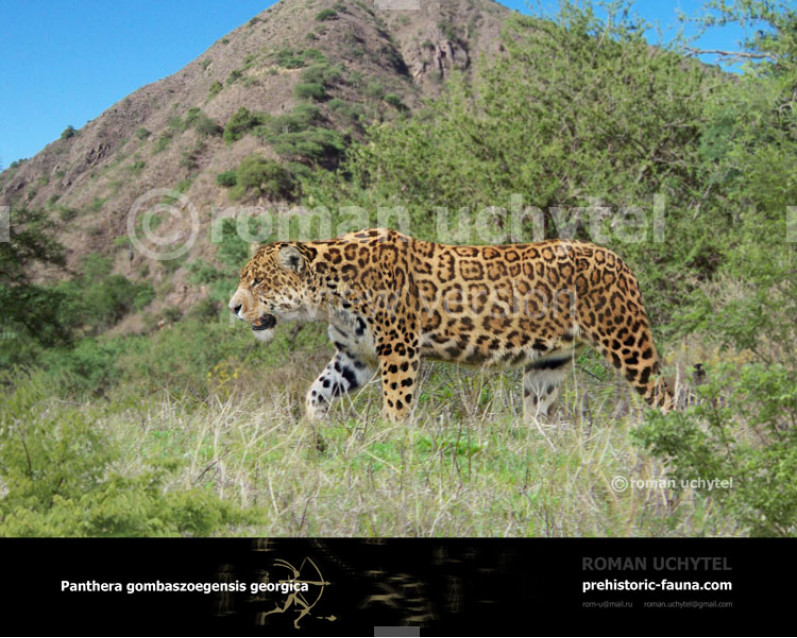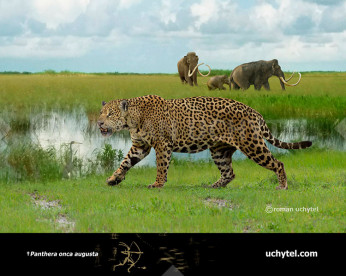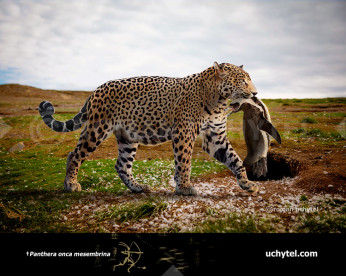Panthera gombaszoegensis georgica
269269Panthera onca georgica ssp
Order: Carnivora
Family: Felidae
Genus: Panthera
Species: P. onca
Dimensions: length - 1,9 m, height - 75 сm, weight - 35-120 kg
Temporal range: during the Early Pleistocene in Eurasia (Republic of Georgia, dated to about 1.77 Myr)
Comparative evaluation of fossil remains of the lower dentition of the jaguar, Panthera onca (Linnaeus, 1758) in the light of recent DNA assessment allows a comprehensive phylogeographic interpretation. The speciation process led a jaguar stem population, clearly of African origin, to disperse over Europe during the time of the Olduvai polarity subchron (1.95-1.77 Myr) (Panthera onca toscana). Based on a hemimandible from Dmanisi, Republic of Georgia, dated to about 1.77 Myr, a new taxon Panthera onca georgica ssp. nov. is proposed for the earliest known Asian member of the species. Its generalized, more cutting dentition mediates between the contemporaneous P. onca toscana and the two later sister subspecies, the Eurasian P. onca gombaszoegensis, which is characterized by a specialized cutting and crushing dentition, and the North American P. onca augusta. Placing the tooth differences within geographic coordinates indicates a central Asian evolutionary node between the latter two forms. Transcontinental dispersal probably brought the jaguar to North America during a glacial period between the Jaramillo polarity subchron and the end of the Matuyama magnetochron (0.99-0.78 Myr), to finally reach South America not before the Rancholabrean. Divergent taxonomic concepts for Pleistocene jaguars are discussed: single species P. onca with several subspecies, two species P. gombaszoegensis and P. onca, or three species P. toscana, P. gombaszoegensis and P. onca.
Panthera onca georgica ssp. nov. from the Early Pleistocene of Dmanisi (Republic of Georgia) and the phylogeography of jaguars (Mammalia, Carnivora, Felidae)
Hemmer, Helmut; Kahlke, Ralf-Dietrich; Vekua, Abesalom K.
Panthera onca georgica ssp
Order: Carnivora
Family: Felidae
Genus: Panthera
Species: P. onca
Dimensions: length - 1,9 m, height - 75 сm, weight - 35-120 kg
Temporal range: during the Early Pleistocene in Eurasia (Republic of Georgia, dated to about 1.77 Myr)
Comparative evaluation of fossil remains of the lower dentition of the jaguar, Panthera onca (Linnaeus, 1758) in the light of recent DNA assessment allows a comprehensive phylogeographic interpretation. The speciation process led a jaguar stem population, clearly of African origin, to disperse over Europe during the time of the Olduvai polarity subchron (1.95-1.77 Myr) (Panthera onca toscana). Based on a hemimandible from Dmanisi, Republic of Georgia, dated to about 1.77 Myr, a new taxon Panthera onca georgica ssp. nov. is proposed for the earliest known Asian member of the species. Its generalized, more cutting dentition mediates between the contemporaneous P. onca toscana and the two later sister subspecies, the Eurasian P. onca gombaszoegensis, which is characterized by a specialized cutting and crushing dentition, and the North American P. onca augusta. Placing the tooth differences within geographic coordinates indicates a central Asian evolutionary node between the latter two forms. Transcontinental dispersal probably brought the jaguar to North America during a glacial period between the Jaramillo polarity subchron and the end of the Matuyama magnetochron (0.99-0.78 Myr), to finally reach South America not before the Rancholabrean. Divergent taxonomic concepts for Pleistocene jaguars are discussed: single species P. onca with several subspecies, two species P. gombaszoegensis and P. onca, or three species P. toscana, P. gombaszoegensis and P. onca.
Panthera onca georgica ssp. nov. from the Early Pleistocene of Dmanisi (Republic of Georgia) and the phylogeography of jaguars (Mammalia, Carnivora, Felidae)
Hemmer, Helmut; Kahlke, Ralf-Dietrich; Vekua, Abesalom K.



-346x277.jpg)

-346x277.jpg)